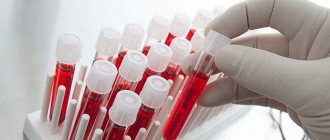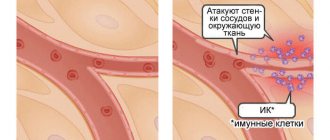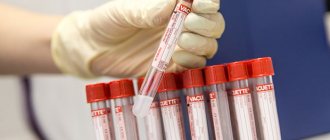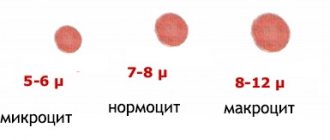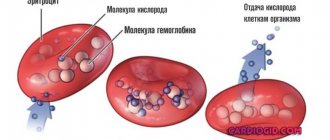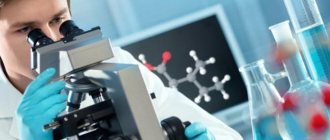Prostate diseases are quite common, especially in males over 40 years of age.
Unfortunately, pathological processes are getting younger and occurring in patients of ever younger age. To detect disorders, specialized examinations are needed.
PSA is a prostate specific antigen, a marker of prostate abnormalities.
The substance is produced there. By its nature it is a protein. PSA is partially released into the blood and circulates in two forms: free and bound.
Both are considered in the system as a single whole and constitute a common prostate specific antigen.
Normally, there is a minimum of substance in the bloodstream; these are rather by-products of metabolic reactions in a small organ.
With problems with the prostate, everything becomes much more interesting: the concentration increases and by the amount one can suspect one or another pathological process.
A PSA test is mandatory, especially for men over 40 years of age, as an initial screening method. There are other reasons for research.
What is worth knowing about this technique?
When are tests ordered?
There are quite a lot of reasons for diagnosis. If we talk about the key ones:
Suspicions of oncological processes
Mostly malignant. Cancerous tumors, prostate carcinomas, are quite common. For every million people, there are about 1,000 cases. There are other calculations that indicate a greater spread of oncology.
Regardless of the statistics, the disease must be detected in the early stages. To react in time and provide quality treatment.
Complete recovery is possible only at an early stage of the pathological process. Next it will be much more difficult.
PSA in prostate cancer jumps several times, plus or minus, depending on the size of the tumor, its exact location and extent.
The general condition of the patient’s body, his health, and immunity also plays a role.
Age 50+ years
During this period, a man is especially susceptible to prostate diseases. Irregular sexual activity, decreased hormone levels, andropause (menopause).
All this leads to disruption of the prostate, increasing the likelihood of cancer and other processes. Including inflammatory ones.
To detect pathologies in time, doctors prescribe laboratory tests. At a minimum, you need to go through them once a year.
It is possible more often if there are risks of pathological processes. For example, the patient has unfavorable heredity or there are other reasons to suspect the imminent onset of deviations.
Diagnosis of prostatitis
The disease is a nonspecific inflammation of the prostate gland. Mainly of a dystrophic nature, due to stagnation of secretions.
Infectious origin is also possible, but according to the European Association of Urology, septic forms account for no more than 10% of the total number of cases.
A PSA blood test allows you to quickly and early detect inflammation of the prostate. This is the key to quality recovery, since it will be difficult or impossible to cope with the disease further. At least without radical methods (surgery).
History of prostate pathologies
Disorders that have already been diagnosed and possibly treated. In this case, the risks are much higher than for average healthy people. Relapses of the pathological process are possible.
It is necessary to approach the issue carefully. It is recommended to undergo examinations every six months to a year. At the discretion of the treating specialist.
Disorders of normal urination
Dysuric disorders. For example, a weak stream, pain during the process, a sudden break. A PSA test is also necessary if the patient is unable to urinate despite wanting to.
Acute urinary retention is an absolute indication for prostate specific antigen testing.
Benign prostatic hyperplasia
It stands apart from other pathological processes. Strictly speaking, this is not a tumor. This is the growth of the prostate's own tissue, an increase in its volume.
But the results are always disastrous. The patient experiences pain and suffers from urinary problems. Accordingly, treatment is necessary. And it is impossible without specific diagnostics.
Changes in the prostate that were obtained using digital rectal examination
Perhaps the urologist discovered changes in the prostate gland and its structure. Next, a PSA test is prescribed and, without fail, an ultrasound technique. To verify a possible diagnosis.
Obvious abnormalities on ultrasound
Disorders of echogenicity, organ structure. Other findings are the basis for laboratory diagnosis. It is important to conduct a full examination to confirm the diagnosis.
Control of therapy
A PSA test is prescribed to promptly detect relapses of the pathological process. Assess how well the patient responds to treatment.
Preoperative assessment
In addition to ultrasound and digital rectal examination. With the help of PSA, the doctor kills two birds with one stone: he checks how pronounced the pathological process is and records the initial indicator.
Further, based on the dynamics of the decrease, we can talk about the quality and effectiveness of the treatment provided.
How is a PSA blood test taken?
How many hours before donating blood sugar can you eat?
Blood is donated on an empty stomach, so it is better not to eat anything on the day on which the collection is scheduled. If you are very thirsty, you can drink, but only regular (not mineral) water. It’s good if a man doesn’t smoke in the morning; if this is impossible, at least for the last hour before entering the office.
There is no need to worry about how to donate blood - the nurse will do everything without the participation of the patient. On his part, you just need to calm down, not worry and go into the office. Blood is taken from a vein in the elbow joint in an amount of no more than 10 ml. A regular syringe is used to collect the material, so the manipulations are painless.
Blood testing is carried out using ELISA analysis, so it does not take more than one day. As a rule, the very next day the doctor receives a sheet with the results and begins to decipher the data.
Preparation and delivery
The steps to prepare for a PSA test are simple. But they must be strictly observed so as not to provoke false results.
The preparation measures are:
- A light diet is recommended for 2 days. No fatty, fried foods. Smoked meats and pickles. It is important not to abuse alcohol, although there are no strict restrictions in this regard.
- You should not take energy drinks or tonic drinks during the day. Be it tea, coffee.
- You should stop cycling in about a week. Especially sports exercises of this kind. Because artificial stagnation of prostate secretion occurs. Why - it has to do with compression of organ tissue during prolonged sitting.
- Within three days they refuse sexual contact. Because sexual intercourse provokes contraction of prostate tissue. The secret goes away. Temporarily, PSA levels may rise or, more rarely, fall.
- Physical overload should also be excluded. At least a few days before the expected analysis.
- Stress can be a factor that causes false results.
On the appointed day you need to go to the laboratory. The specialist will draw blood from a vein. The sample is placed in a test tube and labeled. Sent for research.
After 1-2 days, the patient receives the results in hand. Depending on the clinic, the time frame may be shorter or slightly longer. The analysis itself is not difficult.
Attention:
The terms and conditions of delivery must be observed. In order not to provoke incorrect results.
General information
Prostate specific antigen is a glycated protein, a small part of which, after production by the prostate gland, is released into the bloodstream, where it circulates in 2 states - free and bound. The combination of both of these fractions is the total PSA. Their ratio is approximately 9:1. With prostate carcinoma (cancer), the level of the bound form in the blood increases, which leads to a decrease in the ratio between free and total PSA.
An increase in the level of antigen in plasma is observed in the presence of benign or malignant diseases, inflammatory and infectious processes, mechanical and thermal injuries, as well as after certain therapeutic and diagnostic procedures. A temporary release of the component is caused by ejaculation, after which its level stabilizes again after 2 days.
With age, the concentration of total PSA increases, and the percentage of the free fraction, on the contrary, decreases. A PSA test is recommended annually for men over 50 years of age (age risk group). Early screening (before 40 years of age) is indicated for patients with a burdened medical history (malignant processes in first-line relatives).
Interpretation of test results is always carried out simultaneously with other diagnostic studies: analysis of biological fluids, rectal palpation of the prostate, MRI, biopsy, ultrasound, radiography, etc.
PSA is able to inhibit the migration, proliferation and invasion of endothelial cells in the tumor and, accordingly, slow down its growth. This function may partly explain the naturally slow progression of prostate cancer.
Norms by age
Adequate values depend on the form in which the substance is found. The methods are somewhat different.
PSA total
To understand what this is, let's turn to physiology. The substance is found in two forms.
- Free. In this case, it is functionally active, the enzymatic capability is not inhibited by any other substances.
- Related. The connection does not work and does not affect the body.
Total PSA is the sum of both forms. Calculated as a total. The normal PSA level in the blood for men under 45 years of age will be 0-1.5 ng/ml, and after 70 it is almost 4 times higher: 0-6 ng/ml.
Detailed data is presented in the table:
| Age | Concentration in ng per ml of blood |
| Up to 45 | 0-1.5 |
| 45-60 | 0-2.5 |
| 60-70 | 0-4.5 |
| After 70 years | 0-6 (sometimes they say 6.5) |
There may be some deviations as a result of physiological factors. However, all changes are considered as evidence of potential pathology. Such suspicious phenomena cannot be ignored.
PSA free
It has already been said about it.
Free PSA levels in men are in the range of 0-3.2 ng/ml and increase with age. Detailed data is presented in the table:
| Age (years) | Normal values (in ng/ml) |
| Up to 45 | 0-0.9 |
| 45-50 | 0.5-1.4 |
| 50-60 | 0.6-1.5 |
| 60-70 | 0.9-3 |
| 70 and older | 0.9-3.2 |
Both indicators need to be clearly monitored. Plus, the index plays an important role, which is calculated using the formula: free PSA / total amount * 100%.
It allows you to assess the risks of a pathological process and suspect a particular disease.
Why is this informative?
The medical definition of PSA indicates that normally the bulk of this protein substance is located in the ducts of the gland. Its task is to provide the desired consistency of the seminal fluid and promote its liquefaction. In healthy men, a small portion of the protein passes from the ductal system into the blood vessels and then into the blood. It is this parameter that is monitored during screening.
An increase in the indicator occurs in response to certain changes in the body. With the development of pathology, the barrier between the blood vessels and the ducts of the gland is broken, which causes massive penetration of protein into the blood.
What can give false results
Erroneous results can be obtained for various reasons. In more detail, the following factors play a role.
- Cystoscopy. Endoscopy of the bladder. As a result of stimulation of the urethra and hollow organ, the prostate gland itself is irritated, resulting in an increase in PSA concentration. As a result, the doctor may draw incorrect conclusions.
- Performed prostate massage. It works in much the same way. The smooth muscles of the organ contract. A specific secretion is observed.
The result is an excess of the substance in the bloodstream. To avoid this, first an analysis is carried out, then a massage is prescribed. Not the other way around.
- Sexual activity the day before. Causes approximately the same processes as artificial massage. It is advisable to postpone sexual intercourse until the test is taken.
- Use of a number of medications. Methotrexate, antibiotics, anti-inflammatory, uricosuric drugs. There are even more options, only the main ones are named.
Before taking the test, you need to warn specialists about the treatment. This will help doctors know that false results are possible.
It’s even better to stop therapy for a while, but such issues cannot be resolved on their own. It's worth seeing a doctor.
- Infections of the urinary tract almost always cause false interpretation results. First, it is necessary to treat the underlying pathological process. Only then is a specific examination prescribed.
- Intense physical activity. Especially running, lifting weights, cycling. In order not to provoke false results, all this must be abandoned. For a while.
- All manipulations on the prostate gland. Iatrogenic, that is, medical factor.
All these points need to be corrected. Only a week after this can the examination be carried out.
Reasons for the increase
An increase in PSA concentration is observed more often than a decrease. There can be quite a few culprits for this.
Prostate cancer
It is a malignant tumor. In almost 90% of cases, carcinoma is histologically determined. Specific neoplasia.
The causes are mainly hereditary. Less commonly, long-term chronic inflammation can cause cancer.
Adenoma does not degenerate into other forms of oncology, and therefore is not considered as a significant risk factor.
Symptoms of the disease are quite nonspecific:
- Pain in the groin, in the projection of the prostate (pubic area, anus, external genitalia).
- Urinary disorders.
- Night sleep disorders due to frequent urge to visit the toilet.
- Nausea and weakness.
In the later stages, blood is added to the urine, sudden weight loss occurs, and body temperature rises.
Cancer can only be detected through tests and instrumental tests - neoplasia is indicated by high total PSA levels.
Depending on the concentration, they talk about one or another probability of pathology:
- Up to 10 ng/ml. The risks are low, but already present.
- 11-21 ng/ml - significant chances.
- 20-45 ng/ml - there is a 95% chance of cancer. Most likely metastatic.
- 45-100 ng/ml - 100% risk, most likely there is tissue displacement to regional lymph nodes.
- Above 100 ng/ml, secondary foci of the tumor process are present.
Treatment is carried out under the supervision of a urologist or andrologist.
A triad of activities is required:
- Surgical excision of neoplasia. The smaller it is, the earlier it is detected, the higher the likelihood of radical removal.
- Radiation treatment. Average doses are used. The issue is resolved by specialized specialists.
- Chemotherapy. Appointed immediately. Conducted by the course.
The prognosis is favorable only at the initial stage of the pathological process. That’s why PSA analysis plays such a role in men.
Benign hyperplasia
It is also an adenoma, a growth of healthy prostate tissue. It occurs after 45 years as a result of exposure to negative external factors. The role of heredity has also been proven.
The disease is accompanied by specific symptoms:
- Pain in the projection of the organ.
- Reducing the intensity of the jet.
- Frequent false urge to empty the bladder.
- Well-being disorders.
- Pain during ejaculation.
- Discomfort after sexual activity.
Treatment is carried out under the supervision of a urologist. Special medications are prescribed that slow down tissue proliferation.
If the patient cannot urinate normally, surgery is required. The question of how appropriate it is is decided by the urologist. Weighing all the pros and cons.
Prostatitis
{banner_banstat9}
Acute or chronic inflammatory process. Studies show that only 10% of cases are infectious.
Basically, prostatitis is of dystrophic origin, that is, it begins only with stagnation of prostate secretion. The reasons are not fully understood.
The following factors are believed to play a role:
- Insufficient sexual activity.
- Previous venereal infections.
- Diseases of the urinary tract.
- Also other points. Including hereditary nature.
Treatment is carried out under the supervision of a urologist-andrologist. It is important to follow the correct regimen. Avoid spicy foods and use medications to slow down the process.
Infectious forms are treated with loading doses of antibiotics. Be sure to conduct a study of prostate juice to understand what pathogens provoke the pathological process.
Treatment may take longer. You need to prepare for long-term therapy and constantly follow the recommendations of doctors.
Prostate tissue infarction
{banner_banstat10}
Quite rare. Mainly as a result of blockage of local blood vessels or previous trauma. Accompanied by local bleeding. It is necessary to treat the patient as quickly as possible.
Surgical correction is almost always required. The likelihood of recovery depends on the area of tissue damage.
Patients with prostate ischemia are under special control. Because they are at high risk.
Diseases of the urinary tract
Variety. Here are just some of the possible pathological processes:
- Cystitis.
- Urethritis.
- Nephritis.
- Pyelonephritis.
- Balanitis.
The list goes on and on. The bottom line is that all infectious diseases can change the PSA level in the blood and deviate the indicators. That is why it is so important to detect and differentiate diseases in a timely manner.
Symptoms vary depending on the specific disorder. Common manifestations will be:
- Urinary disorders.
- Unpleasant sensations in the lower back, genital area, anus.
- Discomfort when visiting the toilet.
- Burning and cutting.
- Unpleasant sensations immediately after passing urine.
Treatment. Antibiotics in large doses, specialized antiseptics for internal use. Also vitamin and mineral complexes to correct the disorder.
Blood PSA allows you to diagnose prostate diseases and, in part, pathologies of the urinary tract.
Risk factors for developing prostate diseases
Pathologies of the prostate gland develop against the background of predisposing factors. The greatest importance is genetic predisposition, the presence of cancer in close male relatives.
Age
An important risk factor is age. After 50 years, the risk of cancer increases annually in men. With regard to prostate cancer, the highest probability of developing it is observed in men 65-70 years old. Therefore, it is recommended to take a PSA test regularly after a man reaches 50 years of age.
Genetic predisposition
A family history is a major risk factor. The PSA marker should be monitored in men over 40 years of age if close male relatives have been diagnosed with prostate cancer, especially at a young age.
Overweight
Excess weight plays a role in the development of BPH, glandular adenoma or chronic prostatitis. Excess body weight leads to hormonal imbalance and increased pelvic pressure. This complicates the function of the organ, stagnation occurs, leading to inflammation.
Urogenital infections
Chronic genitourinary infections cause permanent damage to prostate tissue. Mycoplasma and ureaplasma infections cause the greatest harm, since these microorganisms are located intracellularly and are difficult to treat. The human papillomavirus has an oncogenic effect. Carrying this virus increases the likelihood of developing cancer.
Additional examinations
A deviation from the norm in total PSA or the free fraction gives a clue and suggests a disease. But it does not allow us to diagnose pathologies with a 100% guarantee. Therefore, additional events are prescribed.
Among them:
- Consultation with a urologist. If the patient receives therapy from an andrologist.
- Oral interview and history taking.
- Ultrasound of the prostate gland. Used as an informative method for diagnosing tumors and inflammatory processes.
- Research of a specific secret. Allows you to obtain data on the biochemical composition of a substance. An indispensable technique.
- To confirm the tumor process, contrast-enhanced MRI is prescribed. To obtain a better quality drawing, gadolinium-based drugs are administered intravenously.
- Cancer can only be diagnosed after a biopsy and histology of a tissue sample.
PSA testing is an important step in diagnosing the urological profile. It is almost always prescribed. It is worth preparing properly and interpreting the results.
